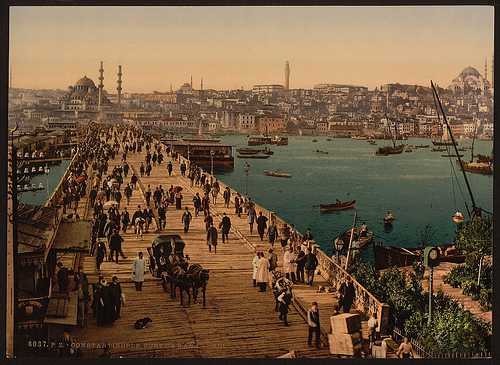TOM MITCHELSON

THERE are scores of people queuing inside Hagia Sophia, a magnificent museum in the ancient city of Istanbul.
They are lining up to touch the perspiration of an angel. They believe that hundreds of years ago the cherub was imprisoned in a column and his sweat slowly drips out of a small hole.
A man standing next to me tells me that the wetness is simply caused by a crack in the marble and he doesn’t think the ‘sweat’ will cure infertility or diseases of the eye, as legend has it. I’m worried about the former, but I don’t believe in the cure, so I make my way to the central part of the building.
Hagia Sophia was built in the sixth century and intended to be the greatest church in the world. Its size, giant dome and mosaics would make this the case today, if it hadn’t been converted into a Mosque nearly a thousand years after it was built, and then later into a museum.
I have always wanted to come to Istanbul, largely because as a child I liked a song called “Istanbul (not Constantinople)” and was eager to know why the confusion. It’s a historic city that’s had a number of name changes down the centuries. It’s been Constantinople, Byzantium and in 1922 became Istanbul. I had also heard how it was the only city in the world that straddles two continents.
This is how I find myself looking out of my hotel window in Europe and staring out across the choppy waters of the Bosphorus to watch some people having dinner in a pavement café in Asia.
I’m staying at the Hilton Istanbul, which I discover is a historic hotel. It dates from 1955 and was a magnet for Hollywood film stars, heads of state and members of royal families. Among its guests were Frank Sinatra, Brigette Bardot, Sophia Loren and Grace Kelly, and it still maintains a certain air of grandeur.
But time for some serious sightseeing. I head to the Basilica Cistern, also known as the Sunken Palace and famous as a background artist in the James Bond film, From Russia With Love. This is a huge underground chamber that used to store water for the city.
The marble columns supporting the massive stone ceiling, and the atmospheric lighting, make the cistern look a bit like a five star hotel lobby that’s had a problem with its drains. The whole building can hold 17million gallons of water, but now there’s just enough water for hundreds of carp to frolic in. Towards the back of the cistern are two blocks of stone with the face of the mythical creature, Medusa, carved into them. One has been placed upside down and the other on its side. This is to avert their gaze, which mythology claimed would turn human beings to stone. Looking around at the scores of mobile tourists it seems to be working.
It is not hard to see why this city was awarded the European City of Culture title last year. Perhaps the most interesting attraction is the Topkapi Palace, for centuries home to the city’s rulers. It houses a collection of beautiful, precious jewel-encrusted exhibits to rival the British crown jewels and has magnificent views of the Bosphorus and Sea of Marmara.
There’s also the Harem (bear in mind you have to pay separately for this part of this palace). This building is a series of inter connecting tiled rooms, some with lattice shutters to keep out prying eyes, and others with beautiful stained-glass windows and elaborately painted ceilings. It is here the Sultan of the day would indulge his fantasies surrounded by his 300 or so concubines, who were supervised by eunuchs. Whatever floats your boat, I guess.
Exquisite
I spent nearly four hours wondering around this exquisite Palace and the only room I avoid is the ‘circumcision room’, because I didn’t like the name.
It’s quite easy to get mosque fatigue in Istanbul but one you shouldn’t miss out on is the Blue Mosque, directly opposite Hagia Sofia. Here the faithful are still called five times a day, as they have been for centuries. Having transferred my shoes to a plastic bag I make my way into the hallowed place of worship. 20,000 blue tiles line the domed building. My nostrils are assailed by the aroma of hundreds of sweaty socks, but this still can’t detract from the majesty of the design.
I am informed by an attendant that the upper levels are for the women worshippers. When I ask him why the separation, he tells me when women bend over to pray, men’s minds may wander from God.
Digesting the searing accuracy of this remark I make my way to the Grand Bazaar, which has been there for nearly 600 years. It is a labyrinth of streets and over 5,000 shops. This is where you’ll literally find more carpets than you can bargain for. The vendors are respectful and don’t hassle you, although they might invite you in for a cup of tea, and in my case, ask whether I could look after the shop for ten minutes.
Istanbul has always sounded exotic to me and as I gaze out across the city skyline, with a heat haze hanging above the minarets and the call to prayer echoing against the walls of modern office blocks and mixing with dance music from the many bars in the city centre, I realise it’s not quite the mystic east as I imagined it at the age of eight, but it is a city with a noble and compelling history.
via Istanbul not Constantinople | The Sun |Travel.

Leave a Reply